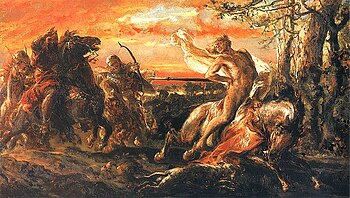This is an old revision of this page, as edited by Volunteer Marek (talk | contribs) at 03:28, 4 March 2013 (ay ay ay). The present address (URL) is a permanent link to this revision, which may differ significantly from the current revision.
Revision as of 03:28, 4 March 2013 by Volunteer Marek (talk | contribs) (ay ay ay)(diff) ← Previous revision | Latest revision (diff) | Newer revision → (diff)
The Crime in Gąsawa was an attack upon a congress of Polish Piast dukes in 1227, which was being held near the village of Gąsawa in Kujawy, Poland. As a result of the ambush the High Duke of Poland Leszek the White was assassinated, while Duke Henry the Bearded of Silesia was heavily wounded. Because several of the victims were retiring for the night and taking a bath at the time of the attack, the event is sometimes known as the Bloodbath of Gąsawa in Polish historiography.
While the direct responsibility for the attack is generally ascribed by historians to Świętopełk of Pomerania, there are many circumstances surrounding the crime which are controversial and remain unexplained. Świętopełk's aim was to make the Duchy of Gdańsk Pomerania, which his House of Sobiesław held as regents of the Polish rulers, independent of Piast overlordship. The murder of Leszek the White, his suzerain, served his interests in that regard. However, several historians have pointed to Duke Władysław Odonic, who shortly before the attack forged an alliance with Świętopełk, as the main instigator of the plot. Odonic's actual target would have been his uncle, Duke Władysław Spindleshanks, with whom Odonic had been involved in a long running feud over the control of Greater Poland (Wielkopolska). Under this hypothesis, Odonic provided Świętopełk's men with information necessary for the success of the ambush, while the latter actually carried out the deed. Other historians have disputed this thesis, pointing out that Spindleshank was not harmed during the attack, that Odonic did not profit from the death of Leszek (with whom he had generally amicable relations) and that there is no record that contemporaries and the families of the slain held Odonic responsible. Rather, in this view, the blame was ascribed retroactively to Odonic several decades later, during fighting between Dukes of Silesia who were descendants of Henry, and those of Greater Poland, who were related to Odonic. A particularly puzzling fact is the absence of condemnation by ecclesiastical authorities (some of whom were present at the meeting) who generally reacted strongly to instances of regicide and took an active role in the political affairs of Poland at the time.

Whatever the exact circumstances of, or the responsibility for, the event, it is generally accepted that the crime contributed to the deepening of the feudal fragmentation of Poland. Świętopełk successfully cast off the control of Piast dukes over Gdańsk Pomerania and began using the title dux (rather than regent). Piast control over this area was not re-established until the Treaty of Kępno between Mściwój II of Pomerania and Przemysł II (perhaps ironically, a grandson of Odonic) in 1282. The death of Leszek the White undermined the authority and status of the "High Duke of Poland" (principat) who technically ruled over all the other regional Polish dukes, with the "seniorate" province of Kraków/Małopolska essentially becoming just another feudal area to be fought over.